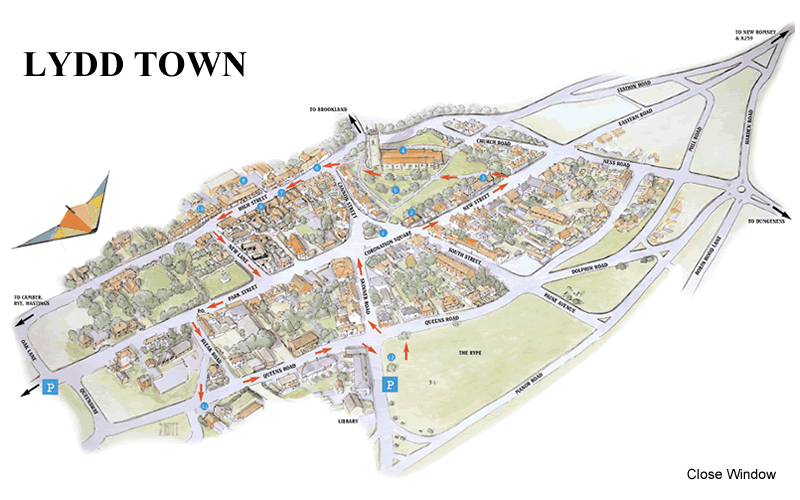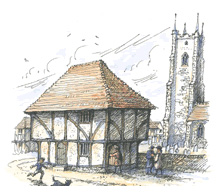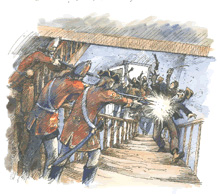Lydd Town Trail

Welcome to Lydd
Pick up a free town trail leaflet and take a short walk around the town to learn of ancient court halls, famous mariners and smugglers. The walk starts here and will take about 30 minutes.
Further details can be obtained from:
- Lydd library (01797 320131)
- Or by visiting www.lyddtownmuseum.co.uk
1. In Celebration
Stables were once located in the centre of Coronation Square which used to be known as Wheeler’s Green. The half-timbered house to the left of the garage is still known by this name. The name of the square was changed in 1901 to commemorate the coronation of Edward VII.
2. Order! Order!
In a corner of the square is a hardware shop called Woolleys. The current exterior disguises one of the oldest and smallest surviving timber-framed court halls in Kent. The court room was located on the upper floor with a lock-up and store room below. Two 16th century royal coats of arms are visible on the inner wall of the court room.
3. Not so New
Despite its name, New Street is thought to be one of the oldest roads in Lydd. The town was originally known as New Bigging. Several 15th century houses give a clue to its true age. The building that now forms numbers 13 to 17 is unusual in that it once contained two open halls. Although its original use remains a mystery, the building may have been a communal dwelling associated with the church.
4. Touching the Sky
The town is dominated by the imposing late 12th century church of All Saints, which at 199ft long is the longest in Kent. Thomas Wolsey, who was vicar at Lydd during the early 16th century, went on to become Cardinal during the reign of King Henry VIII. The church was built on the site of an earlier Saxon church, the remains of which form part of the north west wall behind the marble font. The church sustained heavy bomb damage during World War II but was fully restored following a local fund raising campaign. The church is known locally as the “Cathedral of the Marsh” due to its size and grand double doors.
5. Rest in Peace
The churchyard is the final resting place of Lieutenant Thomas Edgar who sailed the oceans in the company of Captain Cook. Edgar was a skilled mariner in his own right whose survey of the West Falkland Islands in 1786 gave rise to the naming of Port Edgar. His tombstone now sits in the north chapel of the Church. Many local smugglers are also buried at Lydd including Francis Sisley who smuggled silks and laces with the help of his son Thomas based in France. Francis was to become great-grandfather to the Impressionist painter Alfred Sisley.
6. Put ’em up
From Mittells the newsagent, a former public house, look across to the house on the other side of the road. The Beehive was also once a public house, famed for its bare knuckle fighting.
7. Breakout
The haunted George Hotel has a long been associated with the smuggling trade. On a Sunday night in 1721 it was the scene of a pistol skirmish involving nine members of the Mayfield Gang. Leader Gabriel Tomkin was shot in the arm during a battle to release gang members Jacob Walter and Thomas Biggs who were being held under armed guard in an upstairs room. Three officers were also injured in the gun battle. A century later, the inn regularly played host to members of the notorious Aldington Gang.
8. A Load of Hot Air
On the opposite side of the high street to the George Hotel once stood the Edwin Finn Brewery. Finn began brewing in 1862 and at one time owned 18 public houses on the Romney Marsh. The brewery was one of the first to make soda water using the carbonic gas given off as a by-product of the brewing process.
9. Underneath the Arches
The guildhall dates from the 18th century. It originally had open arches and provided cover for some of the traders in a market that extended along the High Street to the North side of the church. In 1819, convicted local smuggler George Walker was being marched from the court to the lock-up alongside the guildhall when a supportive and jostling crowd enabled him to escape his armed escort and flee. Walker was chased into New Street by naval officer Lieutenant Peat who ran him through with his sword.
10. A Safe Passage
Although the frontage of many of the High Street buildings have changed over the years the roofs have stayed the same. Smugglers are said to have used them as escape routes to avoid capture by Preventative Officers.
11. Fetch the Engine
The old fire station was built in 1890. Today the building is maintained by the Friends of Lydd as a museum and contains a wealth of artefacts linked to the town. The museum still houses the original Merryweather fire engine and a number of other interesting vehicles. Amongst these is a unique wide-wheeled beach cart used to carry beer over the shingle from the brewery to the remote coastal pubs in the days before Dungeness was served with roads.
12. For Valour
The large triangular-shaped area of common land surrounded by houses is known as the Rype. The original area of land known as the Rype extended for several miles along the coast both to the East and West of the present town. The Rype was reputedly given to the people of Lydd by the Archbishop of Canterbury as a reward for fighting off an army of Danes in the year 904.


